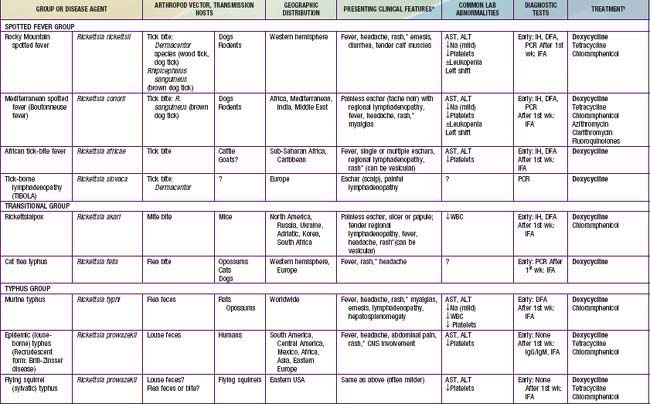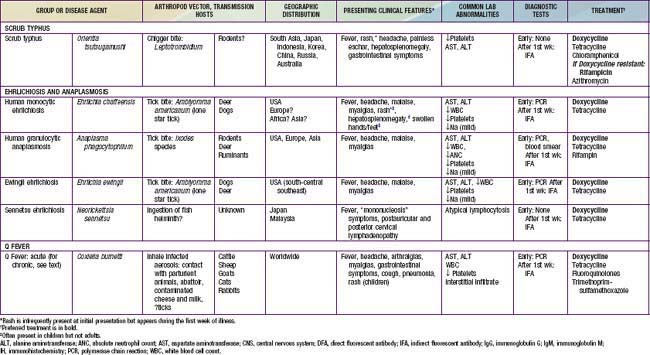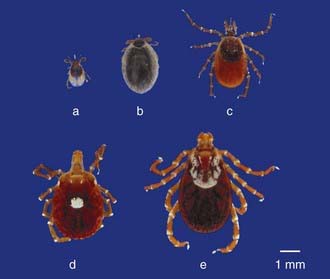Chapter 220 Spotted Fever and Transitional Group Rickettsioses
Rickettsia species were classically divided into “spotted fever” and “typhus” groups based on serologic reactions. The outer membrane protein A (ompA) gene is present in spotted fever but not typhus group organisms. Complete genome sequences have further refined distinctions, and several species that possess ompA, but are genetically distinct from others in the spotted fever group, have been reassigned to a “transitional” group. Many members of the spotted fever group of rickettsiae are pathogenic for humans (Table 220-1). These include the tick-borne agents Rickettsia rickettsii, the cause of Rocky Mountain spotted fever (RMSF); R. conorii, the cause of Mediterranean spotted fever (MSF) or boutonneuse fever; R. sibirica, the cause of North Asian tick typhus; R. japonica, the cause of Oriental spotted fever; R. honei, the cause of Flinders Island spotted fever or Thai tick typhus; R. africae, the cause of African tick bite fever; and unnamed Israeli spotted fever rickettsia, and possibly others. Members of the transitional group include R. akari, the cause of mite-transmitted rickettsialpox; R. felis, the cause of cat flea–transmitted typhus; and R. australis, the cause of tick-transmitted Queensland tick typhus.
Table 220-1 SUMMARY OF RICKETTSIAL DISEASES OF HUMANS, INCLUDING RICKETTSIA, ORIENTIA, EHRLICHIA, ANAPLASMA, NEORICKETTSIA, AND COXIELLA


Infections with other members of the spotted fever and transitional groups are clinically similar to MSF, with fever, maculopapular rash, and eschar at the site of the tick bite. Israeli spotted fever is generally associated with a more severe course, including death in children. African tick bite fever is relatively mild, can include a vesicular rash, and often manifests with multiple eschars. New potentially pathogenic rickettsial species have been identified, including R. slovaca, the cause of TIBOLA (tick-borne lymphadenopathy), and R. parkeri, a cause of eschars in patients bitten by Amblyomma maculatum ticks in North America. R. rickettsii, R. parkeri, R. felis, and R. akari are the only members of the spotted fever and transitional groups that cause autochthonous disease in the USA.
220.1 Rocky Mountain Spotted Fever (Rickettsia rickettsii)
Megan E. Reller and J. Stephen Dumler
Rocky Mountain spotted fever (RMSF) is the most frequently identified and most severe rickettsial disease in the USA. It is also the most common vector-borne disease in the USA after Lyme disease. Although considered uncommon, RMSF is greatly underdiagnosed and underreported. RMSF should be considered in the differential diagnosis of fever, headache, and rash in the summer months, especially after tick exposure. Because fulminant disease and death are associated with delays in treatment, patients in whom the illness is clinically suspected should be treated promptly.
Etiology
RMSF results from systemic infection of endothelial cells by the obligate intracellular bacterium R. rickettsii.
Epidemiology
The term Rocky Mountain spotted fever is historical, because the agent was discovered in the Bitterroot Range of the Rocky Mountains of Montana. Few cases are now reported from this region. Cases have been reported throughout the continental USA (except Vermont and Maine), southwestern Canada, Mexico, Central America, and South America, but not from outside of the Western Hemisphere. In 2006, most cases were reported from North Carolina, Tennessee, Missouri, Oklahoma, Virginia, Arkansas, Alabama, Maryland, Georgia, and South Carolina. Human incursion into previously uninhabited areas has resulted in cases being described in new areas, such as the Northeast USA. The incidence of RMSF has been cyclical but has generally increased over the past decades. The mean number of cases reported each year to the Centers for Disease Control and Prevention (CDC) has steadily increased (515 during 1993-1998, 1,071 during 2001-2004, and 2,000 cases in 2006-2008). Habitats favored by ticks, including wooded areas or coastal grassland and salt marshes, are associated with disease. Foci of intense infection are found both in rural and urban areas. Clustering of cases within families likely reflects shared environmental exposures. In the USA, 90% of cases occur between April and September, months in which humans spend the most time outdoors. The highest age-specific incidence of RMSF among children is seen in those >5 yr of age, with boys outnumbering girls.
Transmission
Ticks are the natural hosts, reservoirs, and vectors of R. rickettsii. Ticks maintain the infection in nature by transovarial transmission (passage of the organism from infected ticks to their progeny). Ticks harboring rickettsiae are substantially less fecund than uninfected ticks; thus, horizontal transmission (acquisition of rickettsiae by taking a blood meal from transiently rickettsemic animal hosts such as small mammals or dogs) significantly contributes to maintenance of rickettsial infections in ticks. Ticks transmit the infectious agent to mammalian hosts (including humans) via infected saliva during feeding. The pathogen R. rickettsii in ticks becomes virulent after exposure to blood or increased temperature; thus, the longer the tick is attached, the greater the risk of transmission. The principal tick hosts of R. rickettsii are Dermacentor variabilis (the American dog tick) in the eastern USA and Canada, Dermacentor andersoni (the wood tick) in the western USA and Canada, Rhipicephalus sanguineus (the common brown dog tick) in the southwestern USA and in Mexico, and Amblyomma cajennense in Central and South America (Fig. 220-1).

Figure 220-1 Tick vectors of agents of human rickettsial diseases. An unengaged nymph (a), engorged nymph (b), and adult female (c) of Ixodes scapularis (deer tick), the vector of Anaplasma phagocytophilum, the cause of human granulocytic anaplasmosis. An adult female (d) of Amblyomma americanum (lone star tick), the vector of Ehrlichia chaffeensis and Ehrlichia ewingii, the causes of human monocytic ehrlichiosis and ewingii ehrlichiosis, respectively. An adult female (e) of Dermacentor variabilis (American dog tick), the vector of Rickettsia rickettsii, the cause of Rocky Mountain spotted fever.
Dogs can serve as reservoir hosts for R. rickettsii, can develop RMSF themselves, and can bring infected ticks into contact with humans. Serologic studies suggest that many patients with RMSF likely acquired the illness from ticks carried by the family dog.
Humans can also become infected when trying to remove an attached tick, because R. rickettsii–containing tick fluids or feces can be rubbed into the open wound at the bite site or into the conjunctivae by contaminated fingers. Finally, inhalation of aerosolized rickettsiae has caused severe infections and deaths in laboratory workers.
Pathology and Pathogenesis
Systemic infection is most obvious on the skin (rash), but nearly all organs and tissues are affected. Following inoculation of tick saliva into the dermis, the rickettsiae attach to the vascular endothelium via protein ligands and initiate rickettsia-mediated injury to host cell membranes. Damage to the membranes induces endocytosis, and the internalized rickettsiae then gain access to the cytosol by continued lysis of vacuolar membranes. Members of the spotted fever group actively initiate intracellular actin polymerization to achieve directional movement, and rickettsiae can easily invade neighboring cells despite minimal initial damage to host cells. The rickettsiae proliferate and damage the host cells by peroxidative membrane alterations, protease activation, or continued phospholipase activity.
The histologic correlate of the initial macular or maculopapular rash is perivascular infiltrates of lymphoid and histiocytic cells with edema but without significant endothelial damage. Proliferation of rickettsiae within the cytoplasm of infected endothelial cells leads to lymphohistiocytic or leukocytoclastic vasculitis of small venules and capillaries, which manifests as a petechial rash. This process ultimately results in microvascular leakage, tissue hypoperfusion, and possibly end-organ ischemic injury. Rickettsiae are contained within endothelial cells of inflamed vessels that may be eccentrically involved. Infrequently, inflammation leads to nonocclusive thrombi. Very rarely, small and large vessels become completely obliterated by thrombosis, which leads to tissue infarction or hemorrhagic necrosis. Interstitial pneumonitis and vascular leakage in the lungs can lead to noncardiogenic pulmonary edema, and meningoencephalitis can cause significant cerebral edema.
The presence of the infectious agent initiates an inflammatory cascade, including release of cytokines such as tumor necrosis factor-α (TNF-α), interleukin 1β, and interferon-γ (IFN-γ). Infection of endothelial cells by R. rickettsii induces surface E-selectin expression and procoagulant activity. Release of chemokines and expression of vascular selectin results in infiltration of the damaged endothelial cells by lymphocytes, macrophages, and occasionally neutrophils. Local inflammatory and immune responses have been suspected to contribute to the vascular injury characteristic of rickettsioses; however, the benefits of effective inflammation and immunity are greater. Blockade of TNF-α and IFN-γ action in animal models diminishes survival and increases the morbidity of spotted fever group infections, probably by abrogating upregulation of nitric oxide synthase and arginine-dependent intracellular killing. Direct contact of infected endothelial cells with perforin-producing CD8 T lymphocytes and IFN-γ–producing natural killer cells helps control the infection. Infection of endothelial cells with Rickettsia leads to upregulated expression of procoagulant molecules and consumption of coagulation factors, platelet adhesion, dissolution of endothelium junctional proteins, and emigration of leukocytes and can lead to disseminated intravascular coagulation (DIC).
Clinical Manifestations
The incubation period of RMSF in children varies from 2 to 14 days, with a median of 7 days. In 60% of cases, patients or their parents report a history of removing an attached tick, although the site of the tick bite is usually unapparent. Epidemiologic clues include living in or visiting an endemic area, playing or hiking in the woods, typical season, similar illness in family members, and close contact with a dog (especially one that is sick). Inapparent or mild illness probably occurs infrequently, but the illness might not be reported. In patients presenting for care, the illness is initially nonspecific, with symptoms including headache, anorexia, myalgias, and restlessness. Pain and tenderness of calf muscles are particularly common in children. Gastrointestinal symptoms including nausea, vomiting, diarrhea, and abdominal pain occur commonly (39-63%) early in the disease.
The typical clinical triad of fever, headache, and rash is observed in 44% of patients overall but is present in only 3% at presentation. Fever and headache persist if the illness is untreated. Fever can exceed 40°C and may be persistently elevated or can fluctuate dramatically. Headache is severe, unremitting, and unresponsive to analgesics.
Stay updated, free articles. Join our Telegram channel

Full access? Get Clinical Tree


